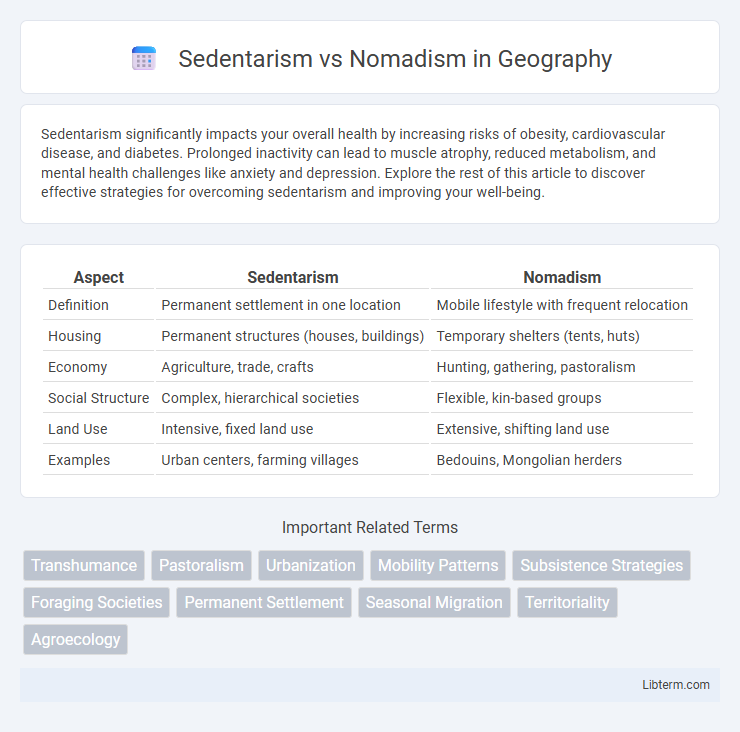Sedentarism significantly impacts your overall health by increasing risks of obesity, cardiovascular disease, and diabetes. Prolonged inactivity can lead to muscle atrophy, reduced metabolism, and mental health challenges like anxiety and depression. Explore the rest of this article to discover effective strategies for overcoming sedentarism and improving your well-being.
Table of Comparison
| Aspect | Sedentarism | Nomadism |
|---|---|---|
| Definition | Permanent settlement in one location | Mobile lifestyle with frequent relocation |
| Housing | Permanent structures (houses, buildings) | Temporary shelters (tents, huts) |
| Economy | Agriculture, trade, crafts | Hunting, gathering, pastoralism |
| Social Structure | Complex, hierarchical societies | Flexible, kin-based groups |
| Land Use | Intensive, fixed land use | Extensive, shifting land use |
| Examples | Urban centers, farming villages | Bedouins, Mongolian herders |
Understanding Sedentarism and Nomadism
Sedentarism refers to a lifestyle characterized by permanent settlement in one location, often associated with agriculture, stable communities, and the development of complex social structures. Nomadism involves continuous or seasonal movement across territories, relying on hunting, gathering, or herding to sustain livelihoods, with a flexible social organization adapted to environmental conditions. Understanding these modes reveals how human societies adapt culturally and economically to their environments, shaping settlement patterns, resource use, and social complexity.
Historical Evolution of Human Settlements
Human settlements evolved from nomadic hunter-gatherer groups to sedentary agricultural communities around 10,000 years ago during the Neolithic Revolution, marked by the domestication of plants and animals. Sedentarism allowed the development of complex societies, permanent architecture, and centralized political structures, contributing to the rise of early civilizations like Mesopotamia and the Indus Valley. Nomadism persisted in regions unsuitable for agriculture, supporting adaptive lifestyles based on livestock herding and seasonal migration, essential for maintaining ecological balance and cultural diversity.
Key Differences Between Sedentarism and Nomadism
Sedentarism is characterized by permanent settlement in one location, fostering stable agriculture, infrastructure development, and community-building. In contrast, nomadism involves regular movement across various terrains to access seasonal resources, emphasizing mobility and adaptability over fixed habitation. Key differences include lifestyle stability, economic practices, and social organization, with sedentarism promoting fixed property ownership and complex societal structures, whereas nomadism prioritizes flexibility and resource-based migration patterns.
Social Structures in Sedentary and Nomadic Communities
Sedentary communities develop complex social structures characterized by hierarchical governance, specialized roles, and established institutions such as schools and religious centers, fostering long-term social cohesion and cultural continuity. Nomadic groups organize social structures around kinship, clans, and flexible leadership, emphasizing mobility and adaptability to environmental changes while maintaining strong interpersonal bonds. The contrast in social organization reflects the differing demands of stationary life, which supports accumulation of wealth and property, versus nomadic life, which prioritizes resource sharing and communal resilience.
Economic Impacts of Sedentarism vs Nomadism
Sedentarism fosters economic growth through stable agricultural production, infrastructure development, and accumulation of surplus resources, enabling trade and specialization. Nomadism emphasizes mobility and flexibility, with economies based on livestock herding and resource exploitation that often limit large-scale wealth accumulation and infrastructure investment. The economic impact of sedentarism thus supports sustained community development, while nomadism prioritizes adaptability over long-term capital formation.
Environmental Adaptations and Sustainability
Sedentarism promotes environmental sustainability by enabling stable land management, consistent agricultural practices, and conservation of local resources. Nomadism involves adaptive strategies such as seasonal migration and flexible resource use that minimize environmental degradation and allow ecosystems to regenerate. Both lifestyles demonstrate unique environmental adaptations, with sedentarism focusing on sustainable cultivation and nomadism on resource mobility and renewal.
Cultural Expressions and Identity Formation
Sedentarism fosters cultural expressions rooted in stable communities, facilitating the development of enduring art, architecture, and rituals tied to specific landscapes, which shape collective identity through shared heritage and continuity. Nomadism promotes fluid cultural expressions marked by adaptability, oral traditions, and portable art forms, reflecting identities that evolve with movement and interaction across diverse environments. Both lifestyles influence identity formation by embedding values and social norms within their respective cultural frameworks, emphasizing either permanence and place or mobility and adaptability.
Technological Advances and Lifestyle Shifts
Technological advances such as the internet, portable devices, and renewable energy solutions have significantly influenced the shift from traditional nomadism to more sedentary lifestyles by enabling remote work and digital connectivity. Lifestyle shifts driven by urbanization and access to healthcare have further reduced the necessity for constant movement, leading to the development of stable communities with advanced infrastructure. The integration of smart home technology and transportation innovations continues to reshape how populations balance mobility and permanence in modern living.
Modern Examples of Sedentarism and Nomadism
Modern sedentarism is exemplified by urban populations working in office-based jobs, relying heavily on technology and infrastructure for daily needs, and engaging in largely sedentary lifestyles. In contrast, modern nomadism is increasingly seen among digital nomads who use remote work capabilities to travel frequently while maintaining employment, and among van-lifers who prioritize mobility and minimalism over permanent residence. The rise of coworking spaces, broadband internet access, and mobile technology has significantly facilitated this contemporary shift toward flexible nomadic living.
Future Trends: Blending Traditions and Innovations
Future trends in sedentarism and nomadism highlight a dynamic fusion of traditional lifestyles with cutting-edge technologies, enabling more flexible mobility without sacrificing community roots. Innovations such as remote work platforms, smart living spaces, and digital nomad visas empower individuals to maintain nomadic freedoms while benefiting from the stability and infrastructure of settled environments. This convergence fosters hybrid models of living that prioritize sustainability, connectivity, and cultural preservation.
Sedentarism Infographic

 libterm.com
libterm.com